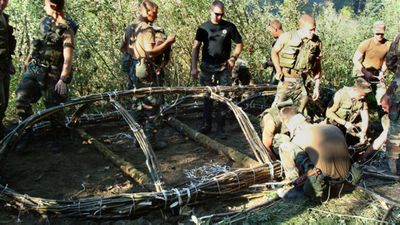Reality TV gets real with ‘Survival School’

Television viewers who like to watch people survive difficult circumstances in primitive conditions have a new show to watch this fall. Forget “Survivor,” with its artificial contests, immunities and votes off the island. Now there’s “Survival School.”
Independent producers filmed a 10-episode series that follows a group of would-be instructors who are trying to pass the grueling five-month course at the Air Force Survival School at Fairchild. The 30-minute episodes will air weekly, starting Sept. 9, on a relatively new, high-definition cable network that shows up on Spokane’s Comcast HD lineup as channel 664.
Local Comcast customers who are baseball fans may be more familiar with that as the channel where they can watch the Mariners in high definition. But when sporting events aren’t on, it’s the home of MOJO HD, which bills itself as a network with “original shows about wide-ranging men’s interests, including high tech, finance, comedy-reality, adventurous travel, music, cuisine and spirits.”
“Survival School” doesn’t fit neatly into any of those categories. It was produced by an independent company, Sirens Media, said the show’s executive producer, Valerie Haselton. One of the people in the development office knew someone who already was a trainer at the Survival School, heard about what he went through and came up with an idea for the show.
A camera crew was able to drop in on a team of survival instructor trainees from their arrival at the Survival School to their graduation, Haselton said.
“We flew out for key events,” she said. They concentrated on field exercises that had the trainees learning to survive in situations that air crews could find themselves if they are shot down, including Arctic conditions, desert, jungle and on the ocean. They learn to kill and eat their food, build fires and shelters, navigate with maps and survive a freak snow storm.
For ocean training, the group was on a small raft, and the camera and sound crew was on a raft next to them, Haselton said. Trainees got seasick, and so did the crew.
“You have to be super fit and pretty intrepid to do this,” Haselton said.
The crew wasn’t allowed to film any elements of the Survival School’s classified prisoner-of-war resistance training, but they were only interested in the outside events anyway, she said.
Promotional material from MOJO HD refers to the shows as a docu-reality series, but Haselton said it isn’t like reality shows that put people in artificial situations to see what they’ll do.
“It’s definitely a documentary,” she said.